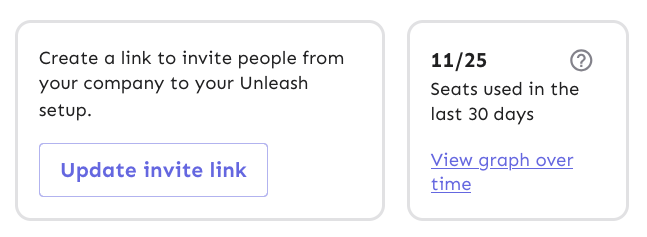This PR throws in a number of fixes to the UsersHeader's invite link and
licensed users components:
- Change the border colors from the primary purple to being a standard
border color
- Fix text / button wrapping in the invite link component. It now wraps
such that the button goes onto the row below the text if it cannot fit
on the same row. The text within the button will not wrap until it
absolutely has to (and is on its own line).
- Fix the wrapping behavior of the licensed users box: the bottom row
("seats used 30 days" and "view graph over time") will now wrap at the
same time as the other button in the other box.
- Fix some text sizes within the licensed users box
- Fix the button to look more like a link in the licensed users box
Most of it is pretty standard fare, but I've taken a slightly different
route when it comes to the licensed users box component.
I switched the whole component to be a "figure" instead of an article. I
was trying to figure out how I could make it behave the way we wanted
visually while still linking the "seats over 30 days" to the "11 /25"
counter text. The examples on MDN use things such as code snippets,
poems, quotes, etc, in addition to the more common image elements. And
in a way, 11/25 is a figure representing the number of seats used, so I
went with that for now. That said, I'd be very interested to hear some
other takes on this.
Now, because the `figcaption` has to be the first or last element of a
`figure` element, I had to include the "open sidebar" button inside the
caption, which isn't ideal. But I can live with it, I think.
Before:



After:



|
||
|---|---|---|
| .. | ||
| .yarn/releases | ||
| cypress | ||
| public | ||
| scripts | ||
| src | ||
| .editorconfig | ||
| .gitignore | ||
| .npmignore | ||
| .nvmrc | ||
| .yarnrc.yml | ||
| check-imports.rc | ||
| cypress.config.ts | ||
| cypress.d.ts | ||
| index.html | ||
| index.js | ||
| orval.config.js | ||
| package.json | ||
| README.md | ||
| tsconfig.json | ||
| tsconfig.node.json | ||
| vercel.json | ||
| vite.config.mts | ||
| yarn.lock | ||
frontend
This directory contains the Unleash Admin UI frontend app.
Run with a local instance of the unleash-api
Refer to the Contributing to Unleash guide for instructions. The frontend dev server runs (in port 3000) simultaneously with the backend dev server (in port 4242):
yarn install
yarn dev
Run with a sandbox instance of the Unleash API
Alternatively, instead of running unleash-api on localhost, you can use a remote instance:
cd ./frontend
yarn install
yarn run start:sandbox
Running end-to-end tests
We have a set of Cypress tests that run on the build before a PR can be merged so it's important that you check these yourself before submitting a PR. On the server the tests will run against the deployed Heroku app so this is what you probably want to test against:
yarn run start:sandbox
In a different shell, you can run the tests themselves:
yarn run e2e:heroku
If you need to test against patches against a local server instance, you'll need to run that, and then run the end to end tests using:
yarn run e2e
You may also need to test that a feature works against the enterprise version of unleash. Assuming the Heroku instance is still running, this can be done by:
yarn run start:enterprise
yarn run e2e
Generating the OpenAPI client
The frontend uses an OpenAPI client generated from the backend's OpenAPI spec. Whenever there are changes to the backend API, the client should be regenerated:
For now we only use generated types (src/openapi/models). We will use methods (src/openapi/apis) for new features soon.
yarn gen:api
rm -rf src/openapi/apis
clean up src/openapi/index.ts imports, only keep first line export * from './models';
This script assumes that you have a running instance of the enterprise backend at http://localhost:4242.
The new OpenAPI client will be generated from the runtime schema of this instance.
The target URL can be changed by setting the UNLEASH_OPENAPI_URL env var.
Analyzing bundle size
npx vite-bundle-visualizer in the root of the frontend directory